From the terrific blog Silent-ology.
Monthly Archives: February 2017
PRAY FOR THE WILDCATS (1974) and some thoughts on the TV-movie genre
The following is my entry in The Movie of the Week Blogathon, being hosted at the blog Classic Film and TV Cafe on Feb. 20, 2017. Click on the above banner, and read bloggers’ takes on some of their favorite (for a variety of reasons) movies made for television!
*
When I was a kid, I was inexplicably fascinated by the concept of TV-movies. Looking back, I think it was because, even though I was too young to articulate it, I realized that at its core, the TV-movie is the television version of “The Emperor’s New Clothes.”
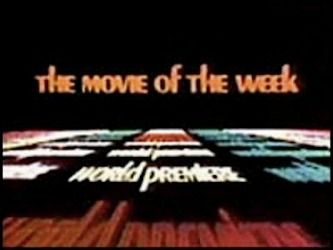
The most famous example, ABC’s “Movie of the Week,” had a snazzy intro in which an announcer told us we’d be seeing “an original, world-premiere movie made especially for ABC.” But of course, it wasn’t really a movie at all; the minimal budget and connect-the-dots script made it perfectly clear that we were watching an hour-long TV episode stretched to 90 minutes.
Further illustrating the chasm of quality between legitimate feature films and made-for-TV movies was the latter’s “star system.” Hollywood has made much hay of their major actors whose quality shone through in movie after movie — Humphrey Bogart, Bette Davis, et al. By contrast, the most apt comparison to TV-movies’ roster of stars would be the Educational Pictures short subjects of the 1930’s, which featured up-and-coming stars who weren’t quite stars (in the TV version, Kate Jackson, Karen Valentine, and Richard Long), or faded stars who’d already seen their heyday (Buddy Ebsen, Barbara Stanwyck, or at the other end of the age spectrum, Barbara Eden).
Finally, there’s the little matter of quality. Yeasayers of TV-movies will quickly point out some of the landmark productions that emerged from the genre — the true-life tearjerker Brian’s Song, Steven Spielberg’s Duel.
But let’s face it — those are the occasional exceptions to the rule. More often, the TV-movie is either a combination of familiar plot and character tropes, or it’s an emasculated version of theatrical cinema’s more daring subject matter. The Stranger Within is really just Rosemary’s Baby made more palatable by turning the innocent mother into spunky Barbara Eden. And the TV-movie I’m going to dissect, Pray for the Wildcats, is really Deliverance minus (let’s face it) those nasty hillbillies and their anal-probing tendencies.
So, long story short, vintage TV-movies are great fun to revisit. But in terms of originality and quality, they resemble theatrical movies about as much as Hanna-Barbera’s cheaper TV progeny resemble Hanna-Barbera’s fluidly animated Tom & Jerry.
*

(WARNING: Major spoilers abound. If you’re interested in seeing the movie first, it’s embedded at the end of this blog.)
Pray for the Wildcats flaunts its TV-movie chops right from the start, showing us four guys careening around in the desert on dirt bikes. This is TV shorthand for “macho white guys.”
It turns out that it’s really three pathetic grown men trying to curry favor from a daddy figure. Sam Farragut is a posturing business executive with a chip of machismo a mile wide on his shoulders. (Sam is played by Andy Griffith with about one part Sheriff Andy Taylor and three parts Lonesome Rhodes from A Face in the Crowd.)
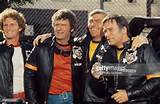
Sam’s three sycophants are ad agency co-workers: free-spirited art designer Maxon (Marjoe Gortner); inattentive husband Paul McIlvain (“The Brady Bunch’s” Robert Reed); and suicidal Warren Summerfield (William Shatner in one of his better post-”Star Trek” performances) who, unbeknownst to the others, has recently been fired from the agency.
The trio try to sell Sam on their latest project for his company, but Sam is decidedly unimpressed. Sam lets the guys know that the only way he’ll sign off on their work is if he’ll accompany him on a dangerous dirt-bike trip through the Baja California desert.
(Sam has strange ideas about living on the edge. Once the guys reluctantly agree to Sam’s plan, Sam has lettermen’s jackets with the name “Wildcats” printed up for the four of them, as if they were going off on some hare-brained fraternity pledge.)
We’re meant to regard Sam menacingly, as a loose cannon who could be set off at the slightest provocation. But there’s nothing in Sam Farragut that we haven’t seen in any fatheated macho who’s had a few too many drinks. In fact, Sam’s rowdy behavior at a seedy Mexican bar is what sets the major part of the plot in motion.
Sam dances with a young blonde at the bar and then tries to have his way with her, even though it’s perfectly clear she’s with another man, who quickly steps in to try and flatten Sam. Warren plays peacemaker and separates the two, but Sam decides that his (one-sided) sense of honor has been squelched.
Later, while dragging Maxon along with him for a ride, Sam looks for and find the young couple camped out on the beach. Sam claims he’s “a hippie with money” and offers the guy $100 to sleep with his girlfriend. For some reason, the couple is not flattered by this offer, and Sam and the guy get into a fight. Just when it looks as though the guy has the upper hand, Sam grabs an axe and destroys the radiator of the couple’s car, leaving them stranded on the beach as Sam exits, an aghast Maxon in tow.
If you haven’t figured out where this is going by now, any further plot synopsis probably won’t help. Suffice to say, Sam Farragut is a perfect symbol of the motto “Save the drama for your mama” long before it was ever conceived, and Sam’s battle with his bruised sense of masculinity wears thin pretty quickly, for the ad execs and for the viewing audience.
Of slightly more interest, as is often the case in TV-movies, is the supporting cast. Janet Margolin, who played the waifish girlfriend of would-be bank robber Woody Allen in Take the Money and Run five years previously, here plays Maxon’s live-in lover Krissie, whose unexpected pregnancy blunts Maxon’s free spirit. A year before Jaws made movie history, Lorraine Gary plays Warren’s wife Lila, who fears for Warren’s sanity. And last but not least, Angie Dickinson plays Nancy — the slinky spouse to whom Paul is inattentive.
Now re-read that previous paragraph. The subtext of this TV-movie is that, even though Sam forces these guys to take this dangerous trip with him, they’re also compelled to do it because they feel trapped. Trapped by these loving women? Trapped by Angie Dickinson?? To the not-yet-created catchphrase “Save the drama for your mama,” we can also add the concept “First-World problems.”
Which pretty much sums up the modus operandi of the worst TV-movies: Take heartfelt, flesh-and-blood issues, and then reduce them to the lowest common denominator so that the most brain-dead yahoo in the audience can understand them. With a goal like that to shoot for, it’s no wonder that TV-movies’ creators stretched 60 minutes into 90 so effortlessly.
If you have any curiosity about watching the movie, here it is in its entirety on YouTube:
For the love of Buster Keaton
The following is my entry in The Third Annual Buster Keaton Blogathon, being hosted by the lovely Lea at her blog Silent-ology from Feb. 19-21, 2017. Click on the above banner, and read bloggers’ tributes to the movies, TV work, and life of this silent-film comedy legend!
*
Film blogger Jim Emerson once wrote that he could see “the end of cinema” – that is, a time down the road when he was entirely sick of going to the movies, having seen it all already. Emerson asked his readers, “Has there been a movie, or a development in movies, that made you feel like saying ‘That’s it! I’m done!’? Where would you draw the line?”
On at least some days, I would draw the line at May 20, 1928. That was the release date of Steamboat Bill, Jr., the final independently produced film of Buster Keaton.
Cinema has continued to thrive since that particular date, of course. But the essence of much of the reason I ever wanted to go to the movies stops right there.
I used to follow movie comedy religiously. But frankly, for the past couple of decades, the coming-attractions trailers have been enough to turn me off. Modern comedies seem interchangeable – the same geeky guys getting into over-their-head situations, either eager to get laid (American Pie) or wishing they hadn’t (Knocked Up), or dealing with situations that any double-digitted IQ would have avoided from the start (What Happens in Vegas, The Hangover).
And finally, there are the guys who seem to aspire to the old school, bringing a reliable persona to film after film. Except that the personas consist mostly of mugging it up (Jim Carrey) or dealing heavily in bodily functions (Adam Sandler).
When I look at all these guys, I just want to shake my head and tell them, “Buster Keaton. You lose.”
What is there to see in modern film comedy that I haven’t seen in Keaton’s best work?
Jim Carrey expects kudos for a bungee jump in Yes Man? Big deal. Try having a real-life two-ton wall fall down all around you, as Keaton did in Steamboat Bill, Jr.
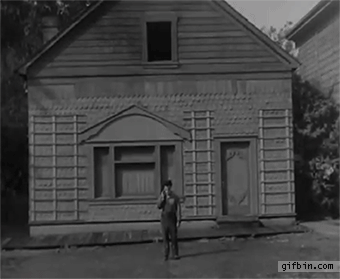
Eddie Murphy or Mike Myers doing multiple roles? Buster Keaton did nine perfectly timed versions of himself on-screen all at once, along with several other roles, in The Playhouse.

Computer-generated special effects? Feh. Watch Keaton literally throw himself into a movie-within-a-movie in Sherlock Jr. (Woody Allen swears this movie wasn’t the inspiration for his own The Purple Rose of Cairo, in which a screen character leaves his movie and enters “real life.” Yeah, right.)
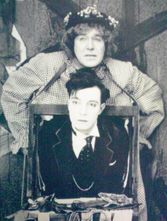
Superhero Movie-type parody? In The Frozen North, Keaton laid waste to 1920’s Western star William S. Hart, making his entrance to the titular snowy territory via a subway kiosk.

Emerson mentions that the late, great movie-bio author William K. Everson (“Who’s that?”, I hear the teenagers saying) had little interest in movies made past the early 1950’s, preferring to stick to the movie world he knew. Like a 21st-century Everson, I find little reason these days to venture beyond my PC, where I can toss in a DVD of Our Hospitality and watch a put-upon but stoic, almost epic comedian nearly kill himself, literally, for his laughs.

For Valentine’s Day – How my wife and I got together
(I was going to save this for a few days from now, but I figured I’d give you a little tidbit to enjoy for the weekend. Plus, I’m an attention hog.)

This is the story of how Kathleen Feindt — publisher and editor of Jacksonville Beach, FL’s weekly newspaper The Beaches Leader — became my wife. It’s a story I’ve been dining out on for decades, because it isn’t every “How we met” story that has two endings.
In July of 1988, a friend of mine called to tell me that Mandarin News — the now-defunct Jacksonville/Mandarin branch of the Leader — had a want ad for a reporter. I needed a job and, having some writing (and extremely minor journalistic) experience, I applied.
Kathy was then the editor of Mandarin News, so I interviewed with her. For the interview, I wore a red tie and a salt-and-pepper dress jacket (a la Barney Fife). For some reason, that made an impression on Kathy.
Later that day, Tom Wood (long-time Leader publisher) asked Kathy how the reporter job search was going. Kathy told Tom about me, going on about my wardrobe and demeanor in great detail. Tom said, “You know, Kathy, you’re interviewing for a reporter, not a husband.”
Kathy did not hire me, as I was living in Orange Park and she preferred to have a reporter who lived in the Mandarin area. However, she kept me on as a free-lance feature writer, to review local theater productions and such. For months, our brief phone conversations went like this:
“Steve, I have tickets for two to the latest production at the local dinner theater. You can review the show and, er, also bring a friend or a date if you’d like.”
“That’s great. I hope I can find somebody to go with me.”
Then one Thursday, I was dropping off a column at Kathy’s office. Kathy usually wasn’t in on Thursdays, but she happened to be in that day. I forget what we talked about, but the conversation was so intriguing, I found excuses to come back two more times to talk to her. When I got home, I took the coward’s way out, phoning Kathy and leaving a date request on her answering machine.
Long story short, three weeks later, I asked her to marry me — which she did, four months after that.
Now…I told you that story to tell you this one.
Kathy and I had both attended the University of Florida in 1981. One day shortly after our marriage, we were reminiscing about UF. Eventually, we realized we had worked together for about three months in UF’s journalism department.
We were polite to each other, but there were no sparks flying at the time. I thought she was too work-minded, and she thought I was too nerdy.
One Friday afternoon, Kathy told me that she and some friends were meeting that day at the Orange & Brew (UF’s on-campus pub), and would I like to join them? I said no because I had a class to attend. Kathy knew then and there, she had no interest in a man who would rather attend class than drink beer.
In March, Kathy and I will celebrate our 28th wedding anniversary. Years ago, Kathy asked me if I had any thoughts as to how we had lasted so long.
I immediately blurted out, “That’s easy. You’re too stubborn to ever admit you made a mistake.”
And I’m still quite happy for her stubbornness. Happy Valentine’s Day.
“Falcon Crest” and the born-again Christian

So you’re skipping along on Facebook, happily reading memes and chatting with friends, when an ad suddenly and incessantly invades your text feed, unknowingly dredging up bitter memories from your past. What do you do?
You bore your blog subscribers by cathartically sharing your bad memory with them, that’s what you do.
In 1983, I was 22 years old and seriously under-dated. My sister-in-law, who was then teaching night school, decided to fix me up with one of her students: Kim, a high-school dropout and divorcee with two young kids. In retrospect, it was easy to see that the only things we had in common were that we were single and hormonally impacted, but for nine solid months, we eked out a facsimile of a loving relationship.
Not to belabor the point, but Kim and I were worlds apart intellectually. I had just graduated from college with a bachelor’s degree in English, and I was embarking on a decade-long career in public teaching. Kim lived with her parents, and she had neither any marketable skills nor any interest in pursuing same. Since she was a hard-core born-again Christian, this meant Kim and I spent ample free time at her parents’ house, watching the most purely strained of Christian TV programs, such as Jim and Tammy Bakker (Remember those winners?).
I’d known the job was dangerous when I took it, so even though I was hardly Southern Baptist material, I nodded my head and watched most of this rated-GGG stuff with Kim. But at 10 p.m. every Friday evening, Kim’s TV watching took a decidedly ungodly turn as she savored, without an ounce of irony, a prime-time soap opera on CBS titled “Falcon Crest.”

This show revolved around the machinations of a California winery and its decidedly bitchy matriarch, Angela Channing. Angela was played by Jane Wyman — and if you remember Wyman as a vulnerable, waifish type in movies and TV shows of the 1940’s and ‘50s, you’d be completely unprepared for the way in which, as Angela, she dominates every inch of the scenery she so gloriously chews.

The show’s premise is that when Angela’s brother dies in a fall, his son and Angela’s nephew Chase (Robert Foxworth) comes to claim his inherited part of Falcon Crest. From there, the battle lines are established between good and evil, with no character nuance in between. For every good character such as Chase’s sunny wife Maggie (Susan Sullivan), there’s someone like Angela’s handsome grandson Lance (Lorenzo Lamas), who would sleep with a tree if it would further his standing with Angela.
If you’re into this kind of soap opera, you’d probably lap up every last bit of it. Me? For an hour every Friday night, I’d think to myself, “What’s with all this friggin’ nastiness? It’s just a winery, people!” And I’d wonder how my little darling Kim, who otherwise professed squeaky-clean Christian credentials, could watch this trash every week and think she was doing herself a favor.
But the show’s richest irony comes before the weekly episode’s plotline even kicks in. At the end of the show’s opening — a splaying line of credits backed by a bombastic orchestral score — comes this little eye-opener:
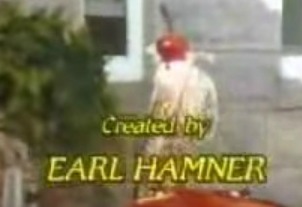
That’s right, folks. Earl Hamner, the same goody-two-shoes who brought you that long-running slice of American apple pie known as “The Waltons,” was responsible for getting this s**t-storm piped into the homes of unsuspecting viewers.
“Falcon Crest” — and the, er, appreciation it garnered from rabid viewers such as Kim — are a perfect symbol of the dichotomy between what America says they want and what they really want. Publicly, they’ll argue that TV and cinema have become boundless and tasteless, and what we need is a return to good old-fashioned, clean entertainment. But throw a “Falcon Crest” on the air, and those same people will send it soaring to ratings heaven — while they’re waiting for the clean entertainment to return to the airwaves, mind you.


